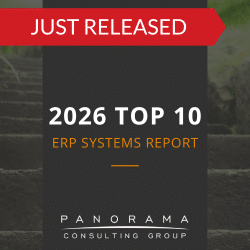The value of artificial intelligence (AI) in the food and beverage (F&B) sector is expected to reach $29.94 billion by 2028. This is up from just $3.07 billion in 2023. As F&B leaders begin to invest more seriously in AI technology, questions are arising around what these solutions will do, who they will benefit, and how they will work.
Today, we’re taking a closer look at the expected role of AI in the food and beverage industry, so you know what to look for as you evaluate enterprise software for your company.
The Connection Between AI and F&B
To imitate human thinking and make intelligent decisions, many AI systems rely on a process called machine learning. Systems equipped with machine learning use algorithms to analyze the data they receive and draw inferences to inform future actions.
How does this affect the F&B industry? Put simply, AI has the potential to optimize nearly every facet of the F&B supply chain.
Today’s AI can analyze an endless number of contributing factors and hypothetical scenarios.
When industry-specific AI applications for this sector become mainstream, business leaders will be able to make more accurate, real-time decisions based on AI-generated supply chain recommendations.
(Learn about the potential of generative AI in demand forecasting.)
Current AI Applications in the F&B Sector
While it might seem as though the full-scale future of AI is still out of reach, many companies are already embracing AI-powered systems.
One example is precision farming. This is a farming practice based on observing, analyzing, measuring, and responding to data about crop variability. Precision farmers use new technologies to increase their crop yields and profitability while simultaneously lowering the number of conventional inputs needed to grow their crops.
Today, precision farmers use AI to analyze past harvests, not only to understand the quality and quantity of crops yielded, but also to understand how factors, such as weather, could affect their outcomes.
With these insights in hand, they can reduce waste and better understand how to proceed. They know which fields need watering at which times, or when to apply fertilizer to achieve the best results.
2025 Top 10 Manufacturing ERP Systems Report
Are you a mid- to large-sized manufacturing firm? This report is for you. Download it now to learn what kind of advanced functionality is available in the market today.
The Role of the Blockchain
We can’t have a conversation about AI in the F&B sector without discussing the role of blockchain technology.
For the global F&B supply chain to be fully optimized, there must be a standardized system that provides full traceability for the entire product lifecycle. This can only be achieved by building a scalable blockchain.
(Learn about AI in supply chain management.)
From misleading labels to food fraud, there have been critical quality and safety issues plaguing the F&B industry. According to one recent survey, only 24% of U.S. consumers feel very confident in the state of the national food supply.
As a result, there’s an increasing call for improved transparency across every step of the supply chain.
The sector needs a standardized system that will allow leaders to track raw materials as they move from seed to sale. However, current solutions have been makeshift at best, and continue to fall short.
Enter the blockchain.
Optimizing the F&B Supply Chain
To date, blockchain is the one technology that’s thought to be scalable enough to support this vision. On the blockchain, endless amounts of data can be processed quickly and securely.
It begins at seed origin, where traceability systems would collect data around food manufacturing, including:
- Quality
- Harvest date and time
- Growing practices
From there, the system would follow the ingredient to the processing plant, analyzing metrics such as resource consumption and quality assurance. This analysis would continue through to the distribution center, where the blockchain would ensure all transport conditions are saved and stored.
When it’s ready for retail, it would track the following information, with insight from the retailer:
- Brand information
- Sustainability
- Quality
- Origin
- Storage temperatures
- Energy consumption
- Handling practices
- Waste
If F&B manufacturers adopt this technology, the result would be a product that contains the full story of where it came from.
Additionally, beyond the consumer, the blockchain could track how the product is recycled or reused.
Leveraging AI in the Food and Beverage Industry
At each step of the supply chain, there’s a need for detailed data capture, management, and analytics. It’s a heavy requirement, but it’s one that can be achieved through AI systems, blockchain technology, and connected enterprise systems, like ERP or SCM software.
To learn more about the expected role of AI in the food and beverage industry and how these solutions could benefit your business, contact our enterprise software consultants below.














